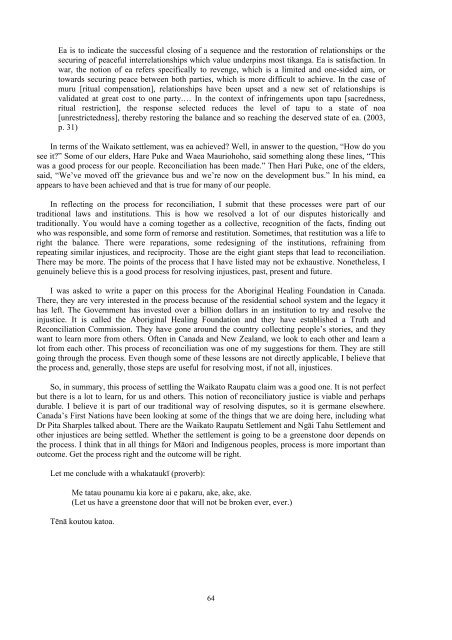traditional knowledge conference 2008 te tatau pounamu
traditional knowledge conference 2008 te tatau pounamu
traditional knowledge conference 2008 te tatau pounamu
You also want an ePaper? Increase the reach of your titles
YUMPU automatically turns print PDFs into web optimized ePapers that Google loves.
Ea is to indica<strong>te</strong> the successful closing of a sequence and the restoration of relationships or thesecuring of peaceful in<strong>te</strong>rrelationships which value underpins most tikanga. Ea is satisfaction. Inwar, the notion of ea refers specifically to revenge, which is a limi<strong>te</strong>d and one-sided aim, ortowards securing peace between both parties, which is more difficult to achieve. In the case ofmuru [ritual compensation], relationships have been upset and a new set of relationships isvalida<strong>te</strong>d at great cost to one party.… In the con<strong>te</strong>xt of infringements upon tapu [sacredness,ritual restriction], the response selec<strong>te</strong>d reduces the level of tapu to a sta<strong>te</strong> of noa[unrestric<strong>te</strong>dness], thereby restoring the balance and so reaching the deserved sta<strong>te</strong> of ea. (2003,p. 31)In <strong>te</strong>rms of the Waikato settlement, was ea achieved? Well, in answer to the question, “How do yousee it?” Some of our elders, Hare Puke and Waea Mauriohoho, said something along these lines, “Thiswas a good process for our people. Reconciliation has been made.” Then Hari Puke, one of the elders,said, “We’ve moved off the grievance bus and we’re now on the development bus.” In his mind, eaappears to have been achieved and that is true for many of our people.In reflecting on the process for reconciliation, I submit that these processes were part of our<strong>traditional</strong> laws and institutions. This is how we resolved a lot of our dispu<strong>te</strong>s historically and<strong>traditional</strong>ly. You would have a coming together as a collective, recognition of the facts, finding outwho was responsible, and some form of remorse and restitution. Sometimes, that restitution was a life toright the balance. There were reparations, some redesigning of the institutions, refraining fromrepeating similar injustices, and reciprocity. Those are the eight giant s<strong>te</strong>ps that lead to reconciliation.There may be more. The points of the process that I have lis<strong>te</strong>d may not be exhaustive. Nonetheless, Igenuinely believe this is a good process for resolving injustices, past, present and future.I was asked to wri<strong>te</strong> a paper on this process for the Aboriginal Healing Foundation in Canada.There, they are very in<strong>te</strong>res<strong>te</strong>d in the process because of the residential school sys<strong>te</strong>m and the legacy ithas left. The Government has inves<strong>te</strong>d over a billion dollars in an institution to try and resolve theinjustice. It is called the Aboriginal Healing Foundation and they have established a Truth andReconciliation Commission. They have gone around the country collecting people’s stories, and theywant to learn more from others. Of<strong>te</strong>n in Canada and New Zealand, we look to each other and learn alot from each other. This process of reconciliation was one of my suggestions for them. They are stillgoing through the process. Even though some of these lessons are not directly applicable, I believe thatthe process and, generally, those s<strong>te</strong>ps are useful for resolving most, if not all, injustices.So, in summary, this process of settling the Waikato Raupatu claim was a good one. It is not perfectbut there is a lot to learn, for us and others. This notion of reconciliatory justice is viable and perhapsdurable. I believe it is part of our <strong>traditional</strong> way of resolving dispu<strong>te</strong>s, so it is germane elsewhere.Canada’s First Nations have been looking at some of the things that we are doing here, including whatDr Pita Sharples talked about. There are the Waikato Raupatu Settlement and Ngāi Tahu Settlement andother injustices are being settled. Whether the settlement is going to be a greenstone door depends onthe process. I think that in all things for Māori and Indigenous peoples, process is more important thanoutcome. Get the process right and the outcome will be right.Let me conclude with a whakataukī (proverb):Me <strong>tatau</strong> <strong>pounamu</strong> kia kore ai e pakaru, ake, ake, ake.(Let us have a greenstone door that will not be broken ever, ever.)Tēnā koutou katoa.64
















